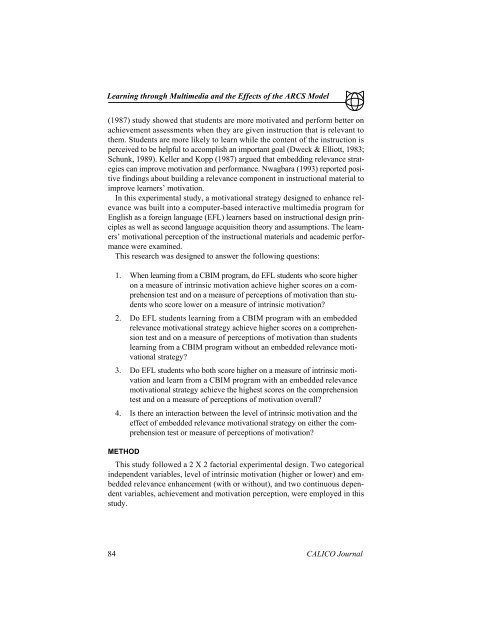Learning Foreign Language through an Interactive Multimedia ...
Learning Foreign Language through an Interactive Multimedia ...
Learning Foreign Language through an Interactive Multimedia ...
Create successful ePaper yourself
Turn your PDF publications into a flip-book with our unique Google optimized e-Paper software.
<strong>Learning</strong> <strong>through</strong> <strong>Multimedia</strong> <strong>an</strong>d the Effects of the ARCS Model<br />
(1987) study showed that students are more motivated <strong>an</strong>d perform better on<br />
achievement assessments when they are given instruction that is relev<strong>an</strong>t to<br />
them. Students are more likely to learn while the content of the instruction is<br />
perceived to be helpful to accomplish <strong>an</strong> import<strong>an</strong>t goal (Dweck & Elliott, 1983;<br />
Schunk, 1989). Keller <strong>an</strong>d Kopp (1987) argued that embedding relev<strong>an</strong>ce strategies<br />
c<strong>an</strong> improve motivation <strong>an</strong>d perform<strong>an</strong>ce. Nwagbara (1993) reported positive<br />
findings about building a relev<strong>an</strong>ce component in instructional material to<br />
improve learners’ motivation.<br />
In this experimental study, a motivational strategy designed to enh<strong>an</strong>ce relev<strong>an</strong>ce<br />
was built into a computer-based interactive multimedia program for<br />
English as a foreign l<strong>an</strong>guage (EFL) learners based on instructional design principles<br />
as well as second l<strong>an</strong>guage acquisition theory <strong>an</strong>d assumptions. The learners’<br />
motivational perception of the instructional materials <strong>an</strong>d academic perform<strong>an</strong>ce<br />
were examined.<br />
This research was designed to <strong>an</strong>swer the following questions:<br />
1. When learning from a CBIM program, do EFL students who score higher<br />
on a measure of intrinsic motivation achieve higher scores on a comprehension<br />
test <strong>an</strong>d on a measure of perceptions of motivation th<strong>an</strong> students<br />
who score lower on a measure of intrinsic motivation?<br />
2. Do EFL students learning from a CBIM program with <strong>an</strong> embedded<br />
relev<strong>an</strong>ce motivational strategy achieve higher scores on a comprehension<br />
test <strong>an</strong>d on a measure of perceptions of motivation th<strong>an</strong> students<br />
learning from a CBIM program without <strong>an</strong> embedded relev<strong>an</strong>ce motivational<br />
strategy?<br />
3. Do EFL students who both score higher on a measure of intrinsic motivation<br />
<strong>an</strong>d learn from a CBIM program with <strong>an</strong> embedded relev<strong>an</strong>ce<br />
motivational strategy achieve the highest scores on the comprehension<br />
test <strong>an</strong>d on a measure of perceptions of motivation overall?<br />
4. Is there <strong>an</strong> interaction between the level of intrinsic motivation <strong>an</strong>d the<br />
effect of embedded relev<strong>an</strong>ce motivational strategy on either the comprehension<br />
test or measure of perceptions of motivation?<br />
METHOD<br />
This study followed a 2 X 2 factorial experimental design. Two categorical<br />
independent variables, level of intrinsic motivation (higher or lower) <strong>an</strong>d embedded<br />
relev<strong>an</strong>ce enh<strong>an</strong>cement (with or without), <strong>an</strong>d two continuous dependent<br />
variables, achievement <strong>an</strong>d motivation perception, were employed in this<br />
study.<br />
84 CALICO Journal
















